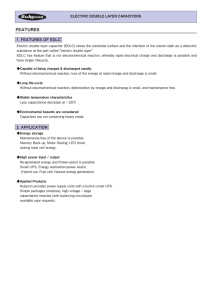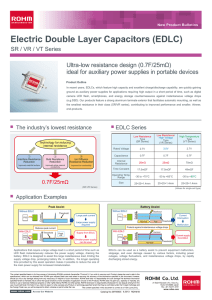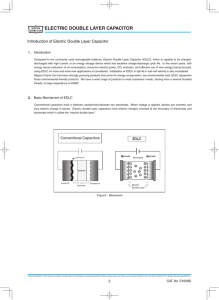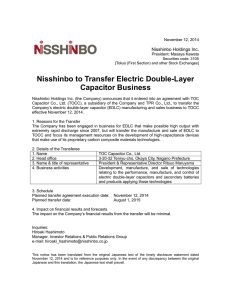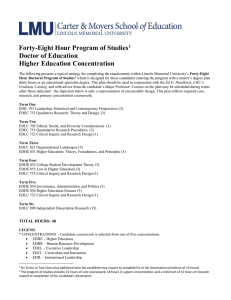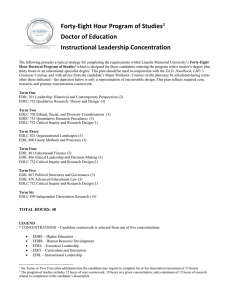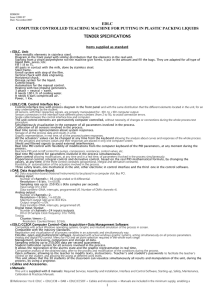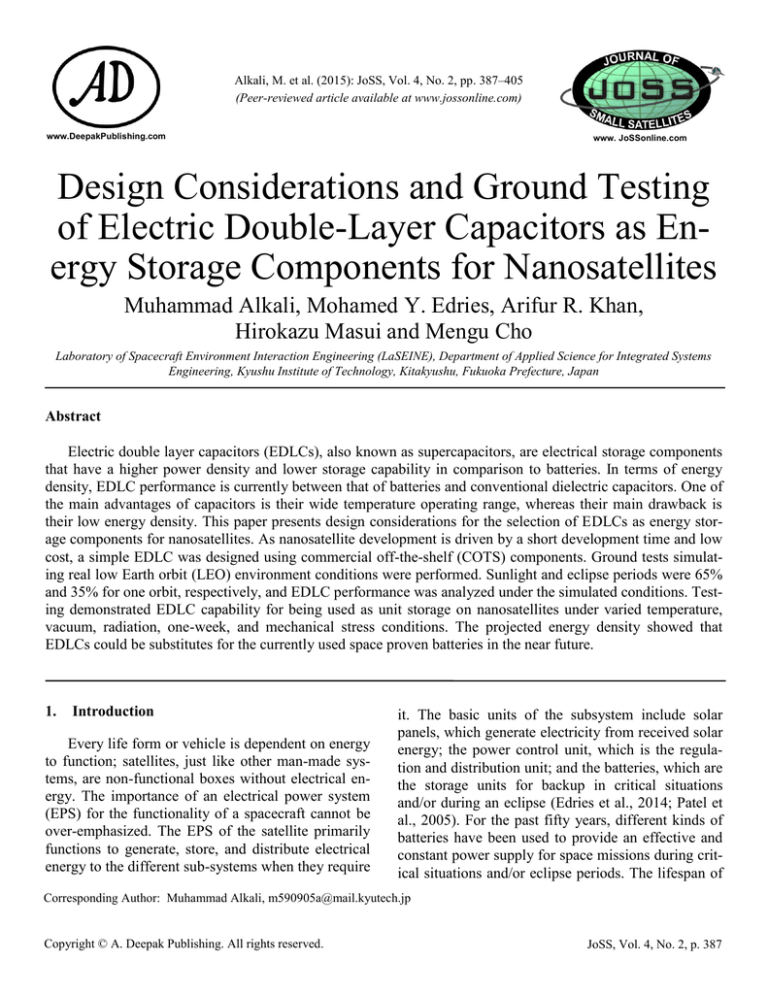
Alkali, M. et al. (2015): JoSS, Vol. 4, No. 2, pp. 387–405
(Peer-reviewed article available at www.jossonline.com)
www.DeepakPublishing.com
www. JoSSonline.com
Design Considerations and Ground Testing
of Electric Double-Layer Capacitors as Energy Storage Components for Nanosatellites
Muhammad Alkali, Mohamed Y. Edries, Arifur R. Khan,
Hirokazu Masui and Mengu Cho
Laboratory of Spacecraft Environment Interaction Engineering (LaSEINE), Department of Applied Science for Integrated Systems
Engineering, Kyushu Institute of Technology, Kitakyushu, Fukuoka Prefecture, Japan
Abstract
Electric double layer capacitors (EDLCs), also known as supercapacitors, are electrical storage components
that have a higher power density and lower storage capability in comparison to batteries. In terms of energy
density, EDLC performance is currently between that of batteries and conventional dielectric capacitors. One of
the main advantages of capacitors is their wide temperature operating range, whereas their main drawback is
their low energy density. This paper presents design considerations for the selection of EDLCs as energy storage components for nanosatellites. As nanosatellite development is driven by a short development time and low
cost, a simple EDLC was designed using commercial off-the-shelf (COTS) components. Ground tests simulating real low Earth orbit (LEO) environment conditions were performed. Sunlight and eclipse periods were 65%
and 35% for one orbit, respectively, and EDLC performance was analyzed under the simulated conditions. Testing demonstrated EDLC capability for being used as unit storage on nanosatellites under varied temperature,
vacuum, radiation, one-week, and mechanical stress conditions. The projected energy density showed that
EDLCs could be substitutes for the currently used space proven batteries in the near future.
1.
Introduction
Every life form or vehicle is dependent on energy
to function; satellites, just like other man-made systems, are non-functional boxes without electrical energy. The importance of an electrical power system
(EPS) for the functionality of a spacecraft cannot be
over-emphasized. The EPS of the satellite primarily
functions to generate, store, and distribute electrical
energy to the different sub-systems when they require
it. The basic units of the subsystem include solar
panels, which generate electricity from received solar
energy; the power control unit, which is the regulation and distribution unit; and the batteries, which are
the storage units for backup in critical situations
and/or during an eclipse (Edries et al., 2014; Patel et
al., 2005). For the past fifty years, different kinds of
batteries have been used to provide an effective and
constant power supply for space missions during critical situations and/or eclipse periods. The lifespan of
Corresponding Author: Muhammad Alkali, m590905a@mail.kyutech.jp
Copyright © A. Deepak Publishing. All rights reserved.
JoSS, Vol. 4, No. 2, p. 387
Alkali, M. et al.
a mission is dependent on the lifetime of uninterruptible power supply, which is based on the number
of life cycles of the storage unit. Rechargeable batteries that can operate for many cycles are, therefore,
well suited for space missions (Hyder et al., 2003;
Patel et al., 2005).
The main energy storage systems currently used
onboard spacecraft are nickel-based batteries such as
nickel-cadmium (NiCd), nickel-hydrogen (NiH2), or
nickel-metal hydride (NiMH) batteries, which are
gaining popularity due to their outstanding performance, close to that of lithium-ion batteries (LIB)
(Hyder et al., 2003; Patel et al., 2005; Ratnakumar et
al., 2003; Alkali et al., 2013, 2014). In this research, a
comparison is made between electric double-layer
capacitors (EDLCs) and NiMH/NiCd batteries, because these are the most highly used storage devices
for nanosatellites. NiH2 batteries are mainly used for
geostationary earth orbit (GEO) communication satellites, which fall out of the scope of this article. LIB
batteries have a lower heritage compared to Ni-based
batteries, even though they have a higher energy density. Their major drawback is thermal run-away,
which puts a burden on nanosatellite developers to
assure their safety.
EDLCs are becoming of interest in the energy
storage industry as stand-alone items or as complements to existing batteries. One of the most attractive
characteristics of EDLCs is their capability for directly storing power without conversions between chemical and electrical energy. EDLCs are safe, with no
risk of explosion or ignition, since they use static
electricity to store power, unlike batteries such as
LIBs, which use chemicals whose reactions can
change with temperature. The electrical power stored
in EDLCs can be quickly supplied. This feature allows for quick discharge, since the energy can easily
be delivered and the reverse process makes it easy for
the energy to be recovered. Moreover, the ratio of
discharging time to charging time under the same
current is almost equal to unit, i.e., 100%, which is
greater than what is obtainable with batteries. EDLCs
can undergo as many as 500,000 cycles, showing performance degradation below 20%, and can perform
effectively within a typical temperature range of
−25°C to 60°C. The electrical charges are separated
Copyright © A. Deepak Publishing. All rights reserved.
in the Helmholtz layers and the activated carbon electrodes have a large area, which provides EDLCs with
low specific energy, low energy density, and high
instantaneous power density. Recently developed
EDLCs have energy densities as high as 7.4 Wh/kg,
whereas Ni-based batteries can have energy densities
as high as 60 Wh/kg (Alkali et al., 2014).
Nanosatellites are defined here as satellites with a
mass typically between 1 and 10 kg. Commercial offthe-shelf (COTS) units are very attractive for
nanosatellite development, due to their short procurement time on one hand, and their low cost on the
other. In 2013, 85 nanosatellites were launched, an
increase of about 300% from 2012. From the projection analysis carried out in 2014 by Space Works, as
many as 400 nanosatellites are expected to be
launched by 2020 (Buchen, 2014). The importance of
nanosatellites cannot be over-emphasized in the educational sector. From nanosatellite development, students gain practical experience in the whole cycle of
a space-related project, which can be seen as professional training with such activities as design evaluation, testing, management, etc. Also of note are the
inherent lessons that are accruable from failures,
since the project cost is low. Nanosatellite systems
suitable for education are desired, and such systems
should be simple, easy to handle, safe, and robust
(Heidt et al., 2000; Nakasuka et al., 2012).
The main function of spacecraft energy storage
components is to maintain a constant power supply
during eclipse periods, during which there are power
cut-offs since the solar cells are not irradiated by sunlight, or in the event of anomalies. The main criteria
for spacecraft energy storage selection are energy
density, cost, multi-cycle capability, mass effectiveness, depth of discharge (DOD), round trip energy
efficiency, vacuum-induced outgassing and sublimation effect of the storage material, voltage stability,
ease in procurement, and availability.
The energy density of a battery or any other storage component is dependent on the cell capacity,
which is determined by fully discharging the cell to a
minimum applicable voltage, so as to maintain maximum performance retention without significantly
degrading the characteristics of the component. Most
energy storage components are conditioned to oper-
JoSS, Vol. 4, No. 2, p. 388
Design Considerations and Ground Testing of Electric Double-Layer Capacitors as Energy Storage Components for Nanosatellites
ate within certain DODs, temperature ranges, minimum ends of discharge, and current strain rates. Nibased batteries have the greatest flight heritage, but
preliminary testing presented in this paper demonstrates that EDLCs show promising performance as
substitutes or complements of batteries for space applications, thanks to their DOD of 100%, wide temperature range; enhanced capacitance; operabililty
under wide charging current (hence no need for strict
current control); and low equivalent series resistance
(ESR). Table 1 compares NiCd, NiMH, and EDLC
energy storage performance.
For a feasibility case survey of EDLCs, this study
considered HORYU-II, a nanosatellite developed at
the Kyushu Institute of Technology (KYUTECH).
HORYU-II was piggyback-launched by Japan Aerospace Exploration Agency (JAXA’s) H-IIA rocket
into polar Earth orbit of 680km on May 18, 2012.
The satellite was equipped with nine AA rechargeable NiMH batteries, each with a capacity of 1900
mAh at a rated voltage of 1.2 V. The combination
used by the satellite was three sets of three seriesand three parallel (3S3P)-connected cells. The equivalent capacity, voltage, and energy were 5700 mAh ,
3.6 V, and 20.52Wh, respectively.
Table 2 shows the specification of state-of-theart, commercially available EDLC cell that was used.
The potential energy was 20.52 Wh, but as NiMH
effectively operates at a DOD of 25%, the energy delivered was 5.13 Wh. HORYU-II’s nine battery cells
weighed 243 g (27 g per cell), and had a net gravimetric energy of 21Wh/kg. To have effective thermal
control, the batteries needed to be accommodated and
harnessed in a thermally and structurally fitted box.
The total mass of the HORYU-II battery unit was 670
g, and the usable gravimetric energy density with respect to the total mass (mass of batteries + mass of
box + harness) was further reduced. Therefore, the
net gravimetric energy density of HORYU-II’s battery unit was 7.66 Wh/kg, with a net volumetric energy density of 20 Wh/l. HORYU-II’s battery was
charged by solar arrays with the open circuit voltage
Table 1. Comparison of NiCd, NiMH and EDLC Performance
Storage Type
NiCd
NiMH
EDLC
Rated voltage [V]
1.2–1.4
1.2–1.4
2.85
Gravimetric energy density [Wh/kg]
60–80
120
7.34
Volumetric energy density [Wh/l]
~60
120
~8
Gravimetric power density [W/kg]
150
500
13000
Operating DOD [%]
25
25
~100
Operating temperature [C]
0 ~ +45
0~ +45
−40 ~ +65
Leakage mitigation
Necessary
Necessary
Necessary
Charge rate
Limited
Limited
Unlimited
Outgassing
Positive effect
Positive effect
Positive effect
Overcharging mitigation
Strictly controlled
-Temperature control
-Voltage control
-Charging current control
Strictly Controlled
-Temperature control
-Voltage control
-Charging current control
Heating issues while recharging
No effect
No effect
No effect
Memory effect
Yes
Yes
No
Self-discharge
Low
Lower
High
Copyright © A. Deepak Publishing. All rights reserved.
Simple
-Less concern for temperature
-Operating charging voltage
below the rated value
JoSS, Vol. 4, No. 2, p. 389
Alkali, M. et al.
Table 2. Specifications of a State-of-the-Art, Commercially Available EDLC Cell
Commercial code mark
BCAP3400 P285
Rated voltage [V]
2.85
Capacitance [F]
3400
Equivalent series resistance (ESR) [mΩ]
0.28
Maximum usable voltage [V]
3
Gravimetric energy density [Wh/kg]
7.4
Volumetric energy density [Wh/l]
9.6
Rated operating temperature range [C]
−40 to +65
Energy (Wh)
3.8
of 9V. The battery charging voltage was adjusted by
inserting a charging regulator (DC/DC converter) between the solar array output and the battery charging
input. A proper balancing between the operational
point of solar array I-V curve and the battery charging is necessary to have an efficient system.
In comparison, EDLCs do not require any thermal control, since they can withstand extreme space
weather conditions and the gravimetric energy density is 7.4 Wh/kg, which corresponds to a volumetric
energy density of 10 Wh/l. EDLCs also require a
charging regulator to maximize the solar array power
output, especially because the EDLC voltage varies
significantly assuming DOD is close to 100%. The
charging regulator consumes little volume or mass.
Therefore, for similar performance to the HORYU-II
battery unit, an EDLC would be less complex and a
well-suited substitute, in terms of gravimetric tradeoff and thermal design. Figure 1 and Table 3 show a
picture of the Horyu-II battery unit with the EDLC
cell and their comparison profile, respectively.
In a comparison between NiMH and EDLC, the
individual voltages and currents for the devices
should be examined. HORYU-II bus voltage was
regulated by the battery voltage, which was generated
by three parallels of three series-connected batteries,
which gave about 4 V during the nominal case. If the
satellite bus is regulated by EDLC voltage, the maximum voltage is likely to be either 2.7 V or 5.4 V,
depending on whether the EDLC is connected in series or not. The EDLC voltage can go down very low,
as DOD would be very large. Power distribution devices should accommodate such a wide variation.
The power distribution circuit suitable for an EDLCregulated bus is a subject for future study.
Figures 2 and 3 show EDLC gravimetric and volumetric energy density trends of development from
Table 3. Comparison of HORYU-II Energy Unit Configuration
with EDLC
Gravimetric
Energy
Density
[Wh/kg]
Volumetric
Energy
Density
[Wh/l]
State-of-art commercial
EDLC
7.4
10
Horyu-II battery (3S3P)
without box
21
49.25
7.66
20
Energy Storage Unit
Figure 1. Battery case for HORYU-II and EDLC cell.
Copyright © A. Deepak Publishing. All rights reserved.
Horyu-II battery unit with
box
JoSS, Vol. 4, No. 2, p. 390
Design Considerations and Ground Testing of Electric Double-Layer Capacitors as Energy Storage Components for Nanosatellites
Figure 2. Trend and forecast up to 2025 of EDLC gravimetric energy density.
2004 to 2015, with projected energy density performance ten years after, based on a survey of the capacitors that were on the market from 2004 to February
2015. According to the ten-year forecast, effectively
by 2025, the energy density of a typical supercapacitor will be gravimetrically increased up to 12.5
Wh/kg. The volumetric energy density will increase
up to 17.5 Wh/l by 2025 (Alkali et al., 2015). The
numbers are sufficient to consider EDLCs energy
storage devices for nanosatellite power systems and
LEO missions. This is especially true for educational
nanosatellites, which favor simple, robust, and safe
design over highly optimized, cutting-edge design.
To determine the strength of the EDLC to extreme LEO conditions, a test was carried out to subject the test article to varied temperature conditions,
Figure 3. Trend and forecast up to 2025 of EDLC volumetric
energy density.
vacuum, and gamma ray irradiation. A simply designed supercapacitor charged regulator (SCR) was
used for the implementation of a charging/discharging cycles test for EDLCs under various
environmental conditions.
This paper consists of four parts. Following this
introduction, Section 2 below describes the experimental setup. The third section discusses the experimental results, and the fourth concludes with suggestions for future work.
2.
Experimental Setup
Table 4 shows the specifications of the EDLC
cell used for the tests. This EDLC cell is a COTS
Table 4. Specifications of the EDLC
EDLC product name
JJD0E408MSED
Rated Voltage [V]
2.5
Capacitance [F] as manufacture’s rated value
4000
Capacitance [F] measured on delivery
4183
ESR [mΩ]
2.2
Maximum Usable Voltage [V]
3
Specific Energy Density [Wh/kg]
3.5
Rated Operating Temperature Range [C]
−25~60
Copyright © A. Deepak Publishing. All rights reserved.
JoSS, Vol. 4, No. 2, p. 391
Alkali, M. et al.
component, and its development did not take into account its use in a space environment. Throughout the
entire test, no padding was done to partially or fully
shield the EDLC from environmental damage. A series of environment tests were run on one single
EDLC cell. The success criteria were that the EDLC
functioned properly in thermal and vacuum environments, and that no significant degradation occurred
after exposure to various environmental factors. The
present study set the judgment criteria of degradation
to 10% change of capacitance and 15% change of
internal resistance between the virgin value measured
on delivery, and the final value after all the tests were
conducted.
Driven by the philosophy of simplicity and low
cost, an SCR unit was designed to extract the
maximum power available from solar panels with
high efficiency in conversion, and developed using
COTS components. The electrical scheme for the
SCR operation is simple, and includes an EDLC as
its energy storage unit (test specimen), an electronic
load, and a power source that simulates solar cell
power generation. The SCR performs instrumentation
of the electrical energy supply from the power source
to the load, and then to the EDLC for its charge. An
SCR circuit diagram is shown in Figure 4. The SCR
contains an adjustable power module (PM), which
is a buck converter (Texas Instruments),
PTH08T230WAD. The buck converter was set to
constantly provide a voltage of 3.42 V with an
adjustable resistor of about 1.1 kΩ. To prevent
current backflow from the EDLC, a diode was
positioned after the PM. Current backflow could
especially occur if the module stops supplying power,
i.e., during discharge time (eclipse simulated time).
Moreover, it also ensures a constant power supply to
the load (satellite bus). The capacitors were included
to reduce ripple voltages, and the two 0.1-Ω-rated
resistors served as measurement points for the DC
and EDLC voltage and currents.
A multi-range DC power supply (PS) (GWINSTEK PSW 80-13.5) was used to simulate the solar cells and power profile. The PS was connected to
the SCR to serve as power input to the power module, the power control unit supplied power to the
EDLC, and the electronic load (PLZ164WA,
KIKUSUI) served as the satellite load. For data acquisition, to simulate a LEO environment with an orbital period of 100 min (65 min sunlight and 35 min
eclipse), the electrical energy supply/cut-off from the
DC PS was controlled by the LabVIEW program.
The 100-minute cycles was used to simplify the 98minute cycle (63 min sunlight and 35 min eclipse) of
HORYU-II, which was launched to 680km. NI DAQ
instruments
were
used
to
observe
the
charge/discharge cycles. With this test setup, the desired charge/discharge cycling of the EDLC could be
performed.
Besides controlling the PS, the program has a selecting feature for the desired load scheme (i.e., con-
Figure 4. Schematic diagram for the test in atmosphere/vacuum.
Copyright © A. Deepak Publishing. All rights reserved.
JoSS, Vol. 4, No. 2, p. 392
Design Considerations and Ground Testing of Electric Double-Layer Capacitors as Energy Storage Components for Nanosatellites
stant power, constant current, or constant resistance).
The program also collates and saves the measuring
data of the PS, load, and the EDLC cell under test.
For temperature variations (high and low temperature
conditions), tests were implemented using a small
thermostatic chamber (900 series – 925E, Despatch
Industries). After testing under atmospheric conditions, the EDLC cell was then exposed to vacuum
conditions (10−5 Pa) at room temperature, using a
vacuum chamber. An overview of the test conditions
is given in Table 5.
The PS was conditioned to provide the input (i.e.,
voltage in (VIN) and current in (IIN)) to the adjustable
buck-converting PM. The 400-µF capacitance filters
any eventual rippled voltage from the PS. The 1.1KΩ resistor sets the output voltage, Vdc, to a value of
3.42 V. The DC current, Idc, value is obtained using
the drop from the first 0.1 Ω after the Vdc. The diode
was positioned to prevent the reverse flow of current
due to EDLC discharging during eclipse time. The
0.1-Ω resistor before the EDLC cell is used to measure IEDLC, which is the current flow in charging of the
EDLC or the EDLC cell discharge current to the load
during eclipse, i.e., when the PS was cut off.
In the first 35 minutes, the power supply was in
off-mode, since the EDLC was not being charged and
it was connected to the load. Immediately after the
35th minute of discharge time, the power supply was
turned on by the LabVIEW program and delivered
input power to the SCR for 65 minutes, as well as to
charge the EDLC. The energy supplied to the SCR
was then buck-converted as VDC. During this period,
the capacitor was charged while delivering 1.2W
power to the load. The choice of 1.2W was to emulate load delivery of 1W, with the assumption of converters between the load and the EDLC during
eclipse delivery. The power level of 1W assumes a
typical power consumption of nanosatellites. Most
converters have efficiency of 80%. During charging
period, the delivered DC current was intentionally
divided, to charge the capacitor and also deliver to
the load.
The power profile employed in the present paper
is very basic, and therefore does not reflect realistic
operation in space, such as occasional high power
consumption due to reasons related to communications or mission. This study intended to answer the
fundamental question whether EDLC can be used for
Table 5. EDLC’s Charging/Discharge Test Conditions
Operation in Atmosphere
Mode
Period [minutes]
PS supplies power
(sunlight simulation)
65
PS cut-off supply
(eclipse Simulation)
35
Each cycle
100
Various operation conditions
No.
EDLC temp. [C]
1
65
2
−25
3
Load
No. of Cycles
Environment
15
Thermostatic Chamber
(TC)
Constant power (CP, 1.2W)
15
TC
−35
Constant power (CP, 1.2W)
15
TC
4
Room temperature
Constant current (CC, 1A)
15
Vacuum Chamber
5
Room temperature
Constant current (CC, 1A)
9
Atmosphere
6
Room temperature
Constant current (CC, 1A)
1
Gamma radiation
Constant power (CP, 1.2W)
Copyright © A. Deepak Publishing. All rights reserved.
JoSS, Vol. 4, No. 2, p. 393
Alkali, M. et al.
space environments onboard nanosatellites. Therefore, simple power profiles, constant power, or constant current, were chosen. More realistic power profiles will be tested in the near future.
A thermostatic chamber (photo and specifications
shown in Figure 5 and Table 6, respectively) was
Figure 5. Photograph of thermostatic chamber (EDLC
was placed inside).
used to create high and low temperature conditions in
the atmosphere, to check the performance of the
EDLC during and after imposition. Before the cell
was inserted in the thermostatic chamber, it was
wrapped in a silver sheet, and nitrogen gas was injected to free the wrap from air, and prevent condensation. Thermocouple sensors were attached to the
EDLC cell to measure the temperature on the EDLC
wall using a temperature DAQ controlled by the
LabVIEW program. Figure 6 shows the test schematic when EDLC cell was set inside the thermostatic
chamber for testing.
The thermostatic chamber was set to create a high
temperature of 65°C or a low temperature of −25°C
and −35°C, during which the charge/discharge tests
were performed under the soak condition. Figure 7
shows the test bench for varying EDLC temperatures
under atmospheric conditions. The LEO environment
vacuum condition at room temperature was created
using a small vacuum chamber (see Figure 8 for the
test schematic, and Table 7 for the chamber specifications).
Figure 9 shows the schematic for the total ionization dose test on the EDLC cell. This radiation test
was conducted using the facilities at the Centre for
Accelerator and Beam Applied Science at Kyushu
University, Japan. Imposition of cobalt 60 (gamma
ray) to the capacitor cell was carried out to verify
whether it could withstand a radiation environment.
A separation distance of 100 cm was selected between the radiation source and the capacitor to obtain
a total ionization dose of 10 krad at the end of 4 h at a
dose rate of 2.5 krad/h. This assumes three years total
dose of silicon in a simple aluminium sphere of 2mm
orbiting in 700km circular orbit of 98 degree inclination (ISO/CD/19683).During the irradiation, the system was operational, and underwent charge and discharge operation for 65 minutes and 35 minutes respectively, for one cycle.
Table 6. Thermostatic Chamber Specifications
Item
Chamber
Specification
900 series – 925E-1-4-0-120
Manufacturer: Despatch Industries
Test volume
0.02 m3
Temperature range
−190˚C to 200˚C
Power
2.392 kVA
Heater
2000 W at 17.4 A
Data Acquisition System
DAQ NI 9213
Data measurement software
LabVIEW
Data Thermocouple type
K-Type
Control Thermocouple type
T-Type
Copyright © A. Deepak Publishing. All rights reserved.
JoSS, Vol. 4, No. 2, p. 394
Design Considerations and Ground Testing of Electric Double-Layer Capacitors as Energy Storage Components for Nanosatellites
Figure 6. Schematic of thermal cycle test setup.
Figure 7. Test bench for testing at various temperatures in atmosphere.
Vacuum chamber
EDLC casing
Shroud
Feed-through
EDLC +
SCR
-
Teflon cube
DAQ
Main valve
Monitoring temperature & pressure
ROTARY PUMP
Valve
TURBO MOLECULAR PUMP
Figure 8. Schematic of the vacuum chamber.
Copyright © A. Deepak Publishing. All rights reserved.
JoSS, Vol. 4, No. 2, p. 395
Alkali, M. et al.
Table 7. Vacuum Chamber Specifications
Chamber wall material
Stainless still (SUS304)
Size
Length: 100cm, Diameter: 30cm
Ultimate vacuum
1.0 x10-3 Pa 1.0 X 10-5 Pa
Operating temperature range
−150C +150C
Thermal Input
Without rail: Cold = Shroud, Hot = Sheet heater
With rail: Cold = Shroud, Hot = IR Lamp
Temperature measuring sensor
K-Type Thermocouple(10CH)
One-week testing was embarked upon to check the
durability of the EDLC after undergoing (non-stop)
operation for over 168 h (7 days). The test conditions
and schematic of the one-week duration experiment
are shown in Table 8 and Figure 10, respectively.
Two functional tests of the EDLC in relation to the
one-week duration experiments were conducted: the
Figure 9. Test schematic for radiation test.
first, referred to as pre-one-week duration testing,
was conducted before the experiment, while the second, here referred to as post-one-week duration testing, was conducted after the seven days experiment.
With the performance comparison from the two functional tests, the durability of the EDLC after undergoing one-week duration testing was deduced.
For the functional tests carried out on or before
the one-week duration testing, the PS was ‘on,’ to
continuously charge the EDLC under constant current-constant voltage (CC-CV) mode until the EDLC
was charged to 2.4 V (the controlling voltage value
for the PS to stop supplying power based on the
LabVIEW program). The supplying current to the
EDLC from the PS is here referred to as Ips, which is
the EDLC current (IEDLC) in the charging stage. From
this point, the EDLC discharged directly to the load
at a constant current of 1 A. (At this stage, the IEDLC
was equal to the load current, IL, until the voltage
dropped to 0.5 V, the value set to trigger the PS ‘on’
for the charging condition).
Table 8. Test Conditions for One-week Duration Test
Test type
LabVIEW logic voltage setting
(V)
Power source condition
EDLC Status
Load condition
PS supplies power (sunlight simulation)
Charge
Standby
0.5V to 2.4V
Discharge
1A/CC mode
2.4V to 0.5V
Charge
Standby
0.2V to 2.8V
Discharge
2A/CC mode
2.8V to 0.2V
Functional
test
PS cut-off supply (eclipse Simulation)
One-week
duration
PS supplies power (sunlight simulation)
PS cut-off supply (eclipse Simulation)
Copyright © A. Deepak Publishing. All rights reserved.
JoSS, Vol. 4, No. 2, p. 396
Design Considerations and Ground Testing of Electric Double-Layer Capacitors as Energy Storage Components for Nanosatellites
IPs
Charging
IL
IEDLC
+
_
Power
Source
For the one-week testing, the PS was ‘on,’ to continuously charge the EDLC under CC-CV mode until
the EDLC was charged to 2.8 V (the controlling voltage value for the PS to stop supplying power based
on the LabVIEW program). From this point, the
EDLC discharged directly to the load at a constant
current of 2 A until the voltage dropped to 0.2 V (the
value set to trigger the power source ‘on’ for the
charging condition and trigger ‘standby mode’ for the
electronic load).
The specifications of the vibration machine used
are given in Table 9. Figure 11 shows the sensor
Discharging
+
_
EDLC
E-Load
Voltage,
Current
EDLC Voltage
LabVIEW
Program
DAQ
Figure 10. Schematic of one-week duration test.
Table 9. Specifications of the Vibration Machine
Items
Specifications
Type
F-35000BD/LA36AP (made by EMIC)
Exciting force
Sine
35.0 kN
Random
28.0 kNrms
No-load maximum
acceleration
Perpendicularity
Sine
1060.0 m/s2
Horizontal
Sine
460.5 m/s2 (0-p)
Maximum loading
mass
Perpendicularity
400kg
Horizontal
500kg
Horizontal vibration
stage
Number of channel
50cm x 50cm
Measurement
16
Control
8
Z-axis
Y-axis
X-axis
EDLC
3-axis acceleration
sensor
EDLC
sensor
EDLC
Jig
Shaker
Jig
Shaker
Z-axis (vibration direction)
X –axis
Y -axis
(vibration direction)
Figure 11. Sensor positions and vibration directions.
Copyright © A. Deepak Publishing. All rights reserved.
JoSS, Vol. 4, No. 2, p. 397
Alkali, M. et al.
positions and vibration direction. The test bench of
random vibration is shown in Figure 12. The
structural integrity of the EDLC is checked by
random vibration testing. Measurement of
acceleration was acquired by accelerometers attached
to the EDLC. The accelerometer data is acquired by a
DAQ system based on the LabVIEW program, and
was quickly processed to a power spectral density
(PSD) pattern after data acquisition. Figure 13 shows
the target PSD pattern applied to the jig. This PSD is
based on H-2A rocket requirement, though the
vibration level (11Grms) was increased to 25 Grms.
The base vibration was applied for 110 s in all three
directions (X, Y and Z).
Two functional tests of the EDLC in relation to
the vibration experiments were conducted: the first,
referred to as pre-vibration testing, was conducted
a
before the experiment, while the second, referred to
as post-vibration testing, was conducted afterwards.
With the performance comparison from the two functional tests, the survival of the EDLC after undergoing random vibration was deduced. A three-axis acceleration sensor was firmly glued onto the side of
the EDLC, which was tightly screwed onto the jig for
performance in the vibration test, based on three random tests under the X, Y, and Z directions. First, the
control accelerometers were placed on the jig top at
the edge, to perform vibration testing under the axial
(Z) direction; after completion of the random test in
the Z-direction, the same shaker and support, connected to the horizontal vibration table, were used for
the X and Y axes vibration tests (transverse vibration).
b
c
Figure 12. a) Vibration machine; b) EDLC on vertical mode of machine; and c) EDLC on horizontal mode of machine.
Figure 13. Input profile of the vibration test.
Copyright © A. Deepak Publishing. All rights reserved.
In addition to vibration testing, shock testing was
also performed. An actual separation shock uses pyrotechnics, and its use is limited to only an allowed
area. Therefore, the shock testing for nanosatellite
components requires a machine free of pyrotechnics.
The shock pattern is normally defined by a shock response spectrum (SRS) pattern, and the patterns are
different from those of the launchers (Masui et al.,
2013). The targeted SRS is the requirement of H-2A
rocket (satellite separation) that gives 6dB/Oct up to
1500 Hz at 2.5x104 m/s2. A typical launcher requirement was considered. A machine equipped with a
hammer (picture shown in Figure 14) was used. Such
JoSS, Vol. 4, No. 2, p. 398
Design Considerations and Ground Testing of Electric Double-Layer Capacitors as Energy Storage Components for Nanosatellites
a.
c.
b.
Figure 14. a) Shock machine; b) the EDLC transversal positioning; and c) longitudinal positioning.
a hammer-type shock machine has enough capability
for a 1 kg component.
The schematic shown in Figure 15 features a
hammer-type shock machine in the configuration.
The capacitor was tightly screwed and clipped to the
jig using two aluminum bands. At the edge of the jig
were two piezoelectric accelerometers positioned for
horizontal (0.7303 pC/g) and vertical (0.70245 pC/g)
charge output measurement after the hammer impacted on the jig. The voltage output was measured using
the DAQ instrument, and archived on the PC. The
shock was applied twice in two directions, one each
for the transversal and longitudinal directions.
files at high temperatures (+65°C). The load scheme
was set at a constant power of 1.2 W, and an energy
of (1.2 W*35*60 s=2520 J) was hence delivered to
the load during eclipse periods (35 min). The voltage
drop at 3901 s was due to internal resistance. During
the charging time, the voltage was quickly recovered.
The charge, Δq (coulomb), is calculated using Equation (1), where i and ∆t are the delivered current and
duration, respectively:
3.
The capacitance, C (Farad), can be deduced using
Equation (2), where q and ∆V are the delivered
charge and the difference in voltage, respectively,
Test Results
The graphs in Figures 16 and 17 show three and
one cycle(s), respectively, of the EDLC voltage pro-
147cm
pivot
∆𝑡
∆𝑞 ∫ 𝑖𝑑𝑡
(1)
0
Amplifier
DAQ
PC
147cm
Jig
Hammer
Piezoelectric
accelerometer
Clipping band
Figure 15. The schematic for shock test.
Copyright © A. Deepak Publishing. All rights reserved.
JoSS, Vol. 4, No. 2, p. 399
Alkali, M. et al.
where Vrated is the rated voltage of the EDLC, i.e., 2.5
V. The relationship between the voltage drop, the actual voltage of the capacitor, VEDLC, and the apparent
measured voltage, Voc, is given by Equation (5). Note
that the voltage drop is a product of the internal resistance, ρ, of the EDLC due to an upset of the current flow reversal (from current flow from the power
source to the capacitor to current flow from the capacitor to the load as the capacitor starts discharging)
and the instantaneous charging current, ic.
Voc = icρ + VEDLC
The relationship between the voltage rise, VEDLC
and Vod, is given by Equation (6). Note the voltage
rise is a product of the internal resistance, ρ, of the
EDLC due to an upset of current flow reversal (from
current flowing from the capacitor to the load as the
capacitor discharges to current flow from the power
source to the capacitor as the capacitor starts getting
charged) and the instantaneous discharging current,
id .
Figure 16. Three cycles of EDLC performance profile at 65°C.
𝜌=
Figure 17. One cycle of EDLC performance profile at 65 degree
Celsius.
from the beginning of discharge after the instantaneous drop to the end of the voltage discharge:
𝐶=
𝑞
∆𝑉
2)
The present paper defines two types of depths of
discharge (DOD), energy and charge, as follows:
𝐷. 𝑂. 𝐷𝑒𝑛𝑒𝑟𝑔𝑦
½𝐶∆𝑉 2
=
2
½𝐶∆𝑉𝑟𝑎𝑡𝑒𝑑
𝐷. 𝑂. 𝐷𝑐ℎ𝑎𝑟𝑔𝑒 =
𝐶∆𝑉
𝐶∆𝑉𝑟𝑎𝑡𝑒𝑑
Copyright © A. Deepak Publishing. All rights reserved.
(5)
(3)
Vod = icρ + VEDLC
(6)
𝑉𝑜𝑐 −𝑉𝑜𝑑
𝑉𝑜𝑐 −𝑉𝑜𝑑
=
𝐼𝑐 −(−𝐼𝑑 )
𝐼𝑐 +𝐼𝑑
(7)
Applying these equations, one can obtain a capacitance
of
3062
(F),
(D.O.D)energy=20(%),
(D.O.D)charge=12(%), and an internal resistance of
0.145 Ω. Table 10 summarizes the capacitance and
the internal resistance of the four test cases listed in
Table 5. As the temperature decreases, the DOD increases, due to an increase in the internal resistance.
From the test results in Table 10, above, as there
is an increase in internal resistance with a decrease in
temperature, so is there a decrease in capacitance
with an increase in temperature (comparing the atmosphere variation test +65°C, −25°C and −35°C).
Also of note, the capacitance available outside the
durability test is within ±10% tolerance from the rated value. In comparing the performance in vacuum
with that in atmosphere, no degradation effect was
(4)
JoSS, Vol. 4, No. 2, p. 400
Design Considerations and Ground Testing of Electric Double-Layer Capacitors as Energy Storage Components for Nanosatellites
Table 10. Summary of Results
Test Condition
Capacitance (F)
Internal resistance(Ω)
+65oC
3062
0.127
−25 C
3233
0.148
−35oC
3255
0.155
Room temperature in vacuum
3307
0.106
Pre-radiation
3746
0.095
During radiation
3649
0.63
Post radiation(8 days after)
3746
0.094
Post radiation (13 days after)
3746
0.095
o
observed due to the vacuum environment. See Equation (8) for the formula of capacitance available:
where capacitance tolerance, Ct, is given by Ct =
(∆C/Crated) 100% with ∆C = Cavailable −Crated.
of the cell. From the calculation of the DOD in the
four cases, there was no degradation on the capacitor
due to radiation exposure.
Table 10 summarizes the capacitance and the internal resistance for pre-radiation, during radiation,
post-radiation (8 days), and post-radiation (13 days).
The EDLC cell was not damaged after exposure to an
ionization dose of 10 Krad.
3.1. Total Ionization Dose on EDLC
3.2. One-week Duration Test
Prior to the total ionization dose (TID) test, a preliminary test was conducted to obtain reference data,
hereafter referred to as pre-radiation exposure. After
the radiation test, series of data were obtained 8 and
13 days after, hereafter referred to as post-radiation
exposure. Figure 18 shows a comparison of EDLC
performance before (Vpre-rad), during (Vradiated), and
after (Vpost-rad) radiation exposure. During the radiation test, the voltage drop at 3900 s is due to the internal resistance. The internal resistance due to the
voltage drop during radiation was 0.63 Ω, and is
much larger than that in pre- and post-radiation tests
(0.095 Ω and 0.094 Ω, respectively). The increased
resistance is due to exposure to the radiation. Considering the fact that the dosage rate is much larger than
that in LEO by four orders of magnitude, the increased resistance would not occur in orbit. The DOD
of the pre-radiation performance is 32%, and 32%
was also measured as the post-radiation performance
Figure 19 shows the one-week duration testing
results of an EDLC charge/discharge cycle test for
seven days. The random spikes seen on the plot were
𝐶𝑎𝑣𝑎𝑖𝑙𝑎𝑏𝑙𝑒 = 𝐶𝑟𝑎𝑡𝑒𝑑 ±
∆𝐶
𝐶𝑟𝑎𝑡𝑒𝑑
100%
Copyright © A. Deepak Publishing. All rights reserved.
(8)
Figure 18. EDLC performance before, during, and after radiation exposure.
JoSS, Vol. 4, No. 2, p. 401
Alkali, M. et al.
Figure 19. Voltage profile of one-week duration test. The first and the last one-day profiles are shown.
due to errors from the DAQ measurement instrument;
this also resulted in little variation in the duration of
cycle. The peak values fluctuated within 2.8±0.1 V
against the targeted value of 2.8 V due to unknown
reasons, most likely external noise entering the DAQ.
Figure 20 shows the first charge/discharge cycle
of the one-week duration test. The EDLC was
Figure 20. First cycle of the one-week duration test.
Copyright © A. Deepak Publishing. All rights reserved.
charged to 2.82 V within 47 min (0.79 h), and there
was a sharp voltage drop within a second to 2.29 V
until the capacitor discharged to 0.19 V at a constant
current of 2 A within 68 min (1.14 h).
Figure 21 shows the last cycle on the 7th day of
the one-week duration test. The EDLC was charged
to 2.81 V within 45.6 min (0.76 h), and there was a
Figure 21. Last cycle on the 7th day of the one-week test.
JoSS, Vol. 4, No. 2, p. 402
Design Considerations and Ground Testing of Electric Double-Layer Capacitors as Energy Storage Components for Nanosatellites
sharp voltage drop within 2 s to 2.2 V until the capacitor discharged to 0.18 V at a constant current of 2 A
within 65.4 min (1.09 h).
From the plots, there was nearly consistency in
the performance under the same conditions.
3.3. Vibration Testing
See Figures 22, 23, and 24 for the response acceleration levels of the EDLC. A summary of the Grms
response is shown in Table 11. The structural integrity of the cell was not affected, even after imposition
Figure 24. PSD response of EDLC at random vibration
in Z direction.
of Grms value greater than 11G. There was no decline in the performance of the EDLC after postvibration functional testing. In addition, based on the
requirements from launcher’s side, the natural frequency in the X, Y, and Z axis must exceed 100Hz,
50Hz, and 50Hz respectively, so as not to match with
the rocket’s natural frequency.
Table 11. Summary of EDLC Grms Response after Excitation
Figure 22. PSD response of EDLC at random vibration in
X direction.
Excited axis
(25Grms applied)
Grms value of
the same axis
First resonant
frequency (Hz)
X
16.5
338
Y
12.3
192
Z
20.6
766
3.4. Shock Test Result
Figure 23. PSD response of EDLC at random vibration in
Y direction.
Copyright © A. Deepak Publishing. All rights reserved.
Figures 25 and 26 show the shock response spectrum (SRS) values measured at the EDLC for each
direction. The directional axis is indicated in Figure
14(b) and (c). The SRS values at 1,000 Hz and 3,000
Hz were approximately 20,000 m/s2 and 90,000 m/s2,
respectively. From 100 Hz to 1,500Hz, the SRS follows the requirement of H-2A satellite separation
shock testing. Beyond 1500Hz, the SRS exceeds the
rocket requirement, 25km/s2.
JoSS, Vol. 4, No. 2, p. 403
Alkali, M. et al.
10% and 15% for the change of capacitance and
internal resistance, respectively.
4.
Figure 25. EDLC SRS response on random shock X direction.
Figure 26. EDLC SRS response on random shock Y direction.
Table 12 summarizes the capacitance and internal
resistance of the EDLC cell before and after each
durability test. The change of capacitance after the
durability test was 5%. The change of internal
resistance after the entire durability test was 9.7%.
These numbers satisfy the experimental criteria of
Table 12. Summary of EDLC after Durability Testing
Condition
Capacitance
(F)
Internal
Resistance
As received from manufacturer (before the series of environment tests)
4183F
0.093
After the series of environment tests
3974
0.102
Copyright © A. Deepak Publishing. All rights reserved.
Conclusions
Electric double-layer capacitors (EDLCs) are
promising as robust and easy-to-handle power storage components for nanosatellites. The disadvantage
of small gravimetric and volumetric energy densities
is constantly diminishing. It is only a matter of time
until the energy densities become comparable to
those of Ni-MH batteries. It is worthwhile to investigate the strength of EDLCs against the space environment. A series of environmental tests was carried
out on a COTS EDLC. The results of hightemperature (+65°C), room-temperature, lowtemperature (−25°C, −35°C), and vacuum tests
showed no serious performance degradation of the
EDLC under those conditions. Furthermore, total
dose ionization, one-week duration, vibration, and
shock tests were conducted. The results from the
EDLC post-functional performance test show the cell
survived the test, which implies that it is robust. The
overall conclusion is that EDLCs can be used on
nanosatellites without any thermal and mechanical
protection. Also, based on the development trend of
the energy density of COTS capacitors, it is projected
that, in or before the year 2018, COTS EDLCs with a
volumetric density as high as 12 Wh/l will flood the
market, and it is anticipated that by 2024, EDLCs
with a gravimetric density as high as 12 Wh/kg will,
as well. This will be revolutionary, especially for
LEO missions or nanosatellites. If a volume increase
of 50% compared to Ni-MH batteries is accepted,
EDLCs can even be used now as power storage units
for nanosatellites.
In the present study, the longest cycle was one
week, far shorter than the typical mission duration of
nanosatellites, which is six months at shortest. The
long-life charging and discharging test is a task for
future work, as well as using a more realistic power
profile. In addition, there is a future plan to perform
temperature cycle testing. As the present tests were
conducted only on a particular type of EDLC, in the
very near future, other types of state-of-the-art
EDLCs on the market will also be tested.
JoSS, Vol. 4, No. 2, p. 404
Design Considerations and Ground Testing of Electric Double-Layer Capacitors as Energy Storage Components for Nanosatellites
Acknowledgements
The authors greatly appreciate the support of Nori
Mohammed and Nam Dung during vibration testing.
We also extend gratitude to our colleagues in the
Space Dynamics Laboratory at KYUTECH (Daikai
Zatsu, Yuma Yanaga and Ammarin Pimnoo), who
allowed us to avail ourselves of their facility for the
making of the jig and base support bands for the vibration and shock tests. Many thanks to Dr. Toru
Hatamura formerly of LaSEINE for his input in the
shock test. Input from Pauline Faure and other members of the Laboratory of Plasma, Laser and Computational Electromagnetics (LaPLACE) is also greatly
appreciated.
References
Alkali, M. et al. (2013): Supercapacitor: Testing Its
Practicability as Power Storage Unit of a
Nanosatellite, presented at the 5th Nanosatellite
Symposium, Tokyo, November 20–22, 2013.
Alkali, M. et al. (2014): Preliminary Study of Electric
Double Layer Capacitor as an Energy Storage of
Simple Nanosatellite Power System, presented at
the 65th International Astronautic Congress
(IAC), Toronto, Canada, September 29–October
4, 2014.
Alkali, M. et al. (2014): Performance Evaluation of
Electric Double-layer Capacitor as Energy
Storage Component of Micro/nanosatellite on the
Imposition of Varied Temperature and Vacuum
Conditions, presented at the 50th AIAA/
ASME/SAE/ASEE Joint Propulsion Conference,
Cleveland, Ohio, July 28–30, 2014.
Alkali, M. et al. (2014): SPIAS: Evolutionary Approach for Space Science Education Development
in Africa, IOSR Journal of Research & Method in
Education (IOSR-JRME) e-ISSN, 2320-7388, pISSN: 2320-737X, Vol. 4, No. 1 Ver. II, pp. 22–
27.
Alkali, M. et al. (2015): Environment Test Campaign
of Commercial-off-the-shelf Components of
Electrical Double Layer Capacitor for space Use,
presented at the 34th ISAS/JAXA Space Power
Copyright © A. Deepak Publishing. All rights reserved.
Symposium, Sagamihara, Japan, Institute of
Space and Astronautical Science (ISAS)/Japan
Aerospace Exploration Agency (JAXA), March
6, 2015.
Buchen, M. (2014): “2014 Nano/Microsatellite
Market Assessment,” SpaceWorks Enterprises,
Inc. (SEI) Atlanta, GA. Available at:
http://www.sei.aero/eng/papers/uploads/archive/S
paceWorks_Nano_Microsatellite_Market_Assess
ment_January_2014.pdf (last accessed August 29,
2015).
Edries, M. Y., Alkali, M., and Cho, M. (2014) : Design and Evaluation of a Nano-satellite Battery
Charge Regulator (BCR) Based on a Simple
Maximum Power Point (MPP) Tracking Control,
presented at the 58th Japan Society of Aeronautical and Space Sciences (JSASS) Conference, Nagasaki, Japan, November 12–14, 2014.
Heidt, H. et al. (2000): CubeSat: A New Generation
of Picosatellite for Education and Industry Lowcost Space Experimentation, presented at the 14th
Annual/USU Conference on Small Satellites, Logan, UT, USA, 2000.
Hyder, A. K. (2003): A Century of Aerospace Electrical Power Technology, Journal of Propulsion
and Power, Vol. 19, No. 6, pp. 1155–1179.
ISO/CD/19683 (2015): Space Systems—Design
Qualification and Acceptance Tests of Smallscale Satellites and Units. Seeking Low Cost and
Fast Delivery (1st ed.), ISO/TC 20/SC 14, International Standards Organization, March 25.
Masui, H., Hatamura, T., and Cho, M. (2013):
Testing of Micro/Nano Satellites and Their Onorbit Performance, presented at the 27th Annual
AIAA/USU Conference on Small Satellites,
Logan, UT, USA, August 10–15, 2013.
Nakasuka, S. and Kawashima, R. (2012): Micro/Nanosatellite Activities by Japanese Universities and Vision towards International Contribution, presented at the Committee on the Peaceful
Uses of Outer Space, 55th session, June 6–15,
2012.
Patel, M. R. (2005): Spacecraft Power Systems, CRC
Press, ISBN 0-8493-2786-5.
Ratnakumar, B. V. et al. (2003): Rover, Journal of
Power Sources, Vol. 119–121, pp. 906–910.
JoSS, Vol. 4, No. 2, p. 405

